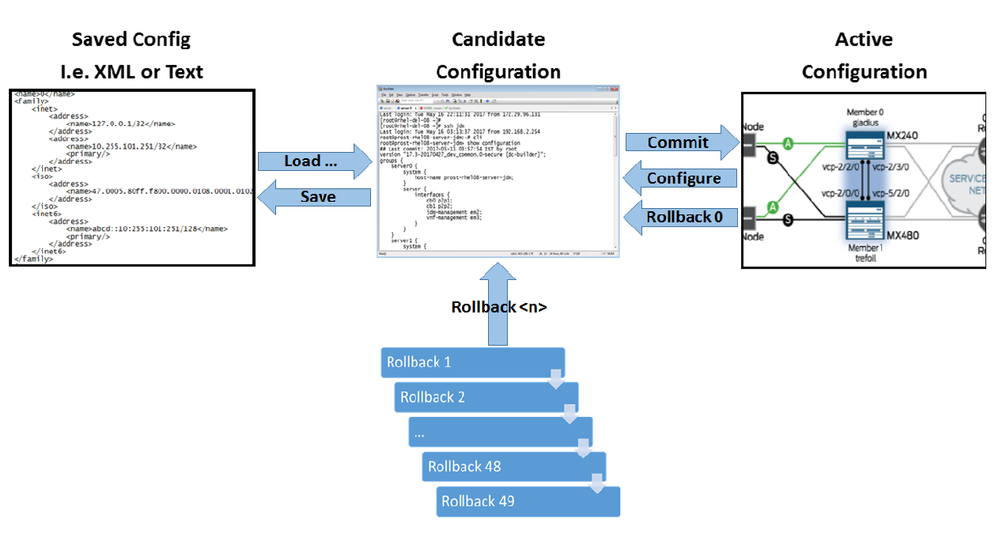We have all suffered through the wait time of committing configurations. It doesn’t matter which OS or hardware platform, we all despise waiting for five minutes or MORE only to end up receiving some sort of error. I believe Einstein’s theory of relativity covers how commit times are perceived longer during those midnight maintenance windows in production… or I could be misinterpreting time dilation.
The good news on this topic is that Juniper has been continuously working on ways to improve the commit times of configurations. The catch is that you will need to upgrade to get these features as they have been trickling into the code for the previous five years.
IMAGE 1: Commit and Configuration Visual

The commit above may be done via CLI or NETCONF. The first step within the commit, the commit check process, invokes all underlaying infrastructure processes to validate the configuration. Each process has the power to reject the configuration. Once all processes pass the "check", the Junos OS continues to process the candidate configuration into the active configuration. The commit check is the most time consuming part of the commit and is the focus of this article. If one wants to bypass the commit check entirely, please learn more about JET and fast programmatic configuration.
COMMIT OPTIMIZATION 1: FAST SYNCHRONIZE
Command: set system commit fast-synchronize
Release: Junos OS 12.2
Summary: This command allows commits to run in parallel on the master and backup routing engine. Recommended use when the REs have almost identical configurations.
COMMIT OPTIMIZATION 2: GROUPS INHERITANCE
Command: set system commit persist-groups-inheritance
Release: Junos OS 13.2
Summary: Full inheritance paths of config groups will be built into the internal database so commit times are decreased when wildcards are used in config groups.
COMMIT OPTIMIZATION 3: DAEMON VALIDATION WITH DELTAS
Default behavior. No command.
Release: Junos OS 13.3
Summary: MGD (Management daemon) passes configurations to the various other daemons within the Junos OS and they individually perform validations on the delta configurations before reporting back to MGD.
COMMIT OPTIMIZATION 4: PRIVATE COMMIT
Default behavior. Command to turn off: set system commit private no-fast-diff
Release: Junos OS 13.3
Summary: Private commit was optimized by including the use of binary databases. Now a patch is generated and applied to the shared database at commit.
COMMIT OPTIMIZATION 5: juniper.conf TEXT FILE CREATION
Command: set system commit delta-export
Release: Junos OS 14.2
Summary: Only the delta in the candidate configuration, rather than the entire candidate configuration, are exported.
COMMIT OPTIMIZATION 6: SYNC BOTH ROUTING ENGINES
Default behavior. Command to turn off: set system commit no-delta-synchronize
Release: Junos OS 14.2
Summary: For both commit synchronize and commit fast-synchronize, the master routing engine generates only the delta to synchronize across both REs.
COMMIT OPTIMIZATION 7: CONSTRAINT VALIDATION
Default behavior. Command to turn off: set system commit no-delta-constraints
Release: Junos OS 14.2
Summary: Related to commit optimization 2, groups inheritance. Once persist-groups is configured in 14.2 and forward, the check is performed on the delta which have constraints instead of the entire configuration.
COMMIT OPTIMIZATION 8: DELTA OF GROUP INHERITANCE
Default behavior. Command to turn off: set system commit no-delta-build-persist-groups
Release: Junos OS 14.2
Summary: Also related to commit optimization 2, groups inheritance. At commit time, only the changed objects would need to be updated in the database.
COMMIT OPTIMIZATION 9: MULTI-PROCESSING DAEMON VALIDATION
Default behavior. Command to turn off: set system commit no-parallel-daemon-validation
Release: Junos OS 15.1
Summary: If one runs an image with FreeBSD 10.X, then SMP (symmetric multi-processing) allows the leveraging of multiple cores to validate sections of the configuration in parallel.
COMMIT OPTIMIZATION 10: FILE PROPAGATION
Default behavior. No command.
Release: Junos OS 16.1
Summary: Junos performs a FFP (foreign file propagation) on the configuration delta as opposed to the entire configuration.
The most troublesome configurations with respect to commit times are BNG configurations. The chart below takes a sample configuration and shows the difference our Juniper test engineers saw.
IMAGE 2: Time Improvements with a BNG Configuration
Beyond being annoyed by the wait, commit times are increasingly important as we move forward with automation and event-driven networks. We will continue to find ways to improve the Junos OS and commit times are just one example of what we are doing here at Juniper.
WARNING: Virtual devices lag behind our hardware devices in these "commit" improvements. However, we are working on that, as well.